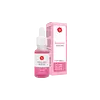What's inside
What's inside
 Key Ingredients
Key Ingredients

 Benefits
Benefits

 Concerns
Concerns

 Ingredients Side-by-side
Ingredients Side-by-side

Water
Skin ConditioningButylene Glycol
HumectantPropylene Glycol
HumectantGlycolic Acid
BufferingGlycerin
HumectantSuccinic Acid
BufferingSilanediol Salicylate
EmollientEthoxydiglycol
HumectantPEG-40 Hydrogenated Castor Oil
EmulsifyingTrideceth-9
EmulsifyingSodium Lactate
BufferingSodium PCA
HumectantHydroxypropyl Methylcellulose
Emulsion StabilisingDMDM Hydantoin
PreservativeGlycyrrhiza Glabra Root Extract
BleachingTriethanolamine
BufferingSodium Hydroxide
BufferingTetrasodium EDTA
Iodopropynyl Butylcarbamate
PreservativeFructose
HumectantGlycine
BufferingInositol
HumectantLactic Acid
BufferingNiacinamide
SmoothingUrea
BufferingGlabridin
BleachingBenzoic Acid
MaskingSodium Benzoate
MaskingSodium Methylparaben
PreservativeSodium Chloride
MaskingPropylparaben
PreservativeCI 14720
Cosmetic ColorantCI 15985
Cosmetic ColorantCI 42090
Cosmetic ColorantWater, Butylene Glycol, Propylene Glycol, Glycolic Acid, Glycerin, Succinic Acid, Silanediol Salicylate, Ethoxydiglycol, PEG-40 Hydrogenated Castor Oil, Trideceth-9, Sodium Lactate, Sodium PCA, Hydroxypropyl Methylcellulose, DMDM Hydantoin, Glycyrrhiza Glabra Root Extract, Triethanolamine, Sodium Hydroxide, Tetrasodium EDTA, Iodopropynyl Butylcarbamate, Fructose, Glycine, Inositol, Lactic Acid, Niacinamide, Urea, Glabridin, Benzoic Acid, Sodium Benzoate, Sodium Methylparaben, Sodium Chloride, Propylparaben, CI 14720, CI 15985, CI 42090
Water
Skin ConditioningGluconolactone
Skin ConditioningButylene Glycol
HumectantGlycolic Acid
BufferingPentylene Glycol
Skin ConditioningPEG-40 Hydrogenated Castor Oil
EmulsifyingBetaine
HumectantSodium Citrate
BufferingPolyacrylate Crosspolymer-6
Emulsion StabilisingSalicylic Acid
MaskingSodium Hydroxide
BufferingPhenoxyethanol
PreservativeAllantoin
Skin ConditioningHydrolyzed Jojoba Esters
Skin ConditioningXanthan Gum
EmulsifyingAloe Barbadensis Leaf Juice
Skin ConditioningTriethylene Glycol
MaskingCI 14720
Cosmetic ColorantCI 42090
Cosmetic ColorantCI 19140
Cosmetic ColorantWater, Gluconolactone, Butylene Glycol, Glycolic Acid, Pentylene Glycol, PEG-40 Hydrogenated Castor Oil, Betaine, Sodium Citrate, Polyacrylate Crosspolymer-6, Salicylic Acid, Sodium Hydroxide, Phenoxyethanol, Allantoin, Hydrolyzed Jojoba Esters, Xanthan Gum, Aloe Barbadensis Leaf Juice, Triethylene Glycol, CI 14720, CI 42090, CI 19140
Ingredients Explained
These ingredients are found in both products.
Ingredients higher up in an ingredient list are typically present in a larger amount.
Butylene Glycol (or BG) is used within cosmetic products for a few different reasons:
Overall, Butylene Glycol is a safe and well-rounded ingredient that works well with other ingredients.
Though this ingredient works well with most skin types, some people with sensitive skin may experience a reaction such as allergic rashes, closed comedones, or itchiness.
Learn more about Butylene GlycolWe don't have a description for CI 14720 yet.
Ci 42090 is a synthetic dye created from petroleum. It is used to give a bright blue color to cosmetics, medicine, and food.
Glycolic Acid is arguably the most famous alpha hydroxy acid (AHA) with tons of research backing its benefits.
It is found naturally in sugar cane but the form used in skincare is usually synthetic for purity and stability.
Glycolic acid removes the top layer of dead skin cells to allow newer and fresher ones to emerge.
AHAs work by breaking down the structural “glue” that holds old skin cells in place. When that buildup is gone, your skin can renew itself more efficiently.
Research also shows glycolic acid stimulates collagen production, helping to firm and thicken the skin over time. This is one of its biggest advantages over other AHAs.
Overall, glycolic acid helps with:
Fun fact: Glycolic acid boosts skin hydration by helping it produce molecules that increase hyaluronic acid naturally.
To work best, glycolic acid products should have a pH between 3-4 (that’s where exfoliation is most effective but still gentle on skin).
The pH and concentration of a product are key to its effectiveness:
It is normal to feel a slight stinging sensation when using glycolic acid. This usually fades as your skin adjusts.
Because glycolic acid has the smallest molecular size in the AHA family, it can penetrate deeper, which enhances its effectiveness but also makes it more likely to irritate sensitive skin.
If your skin is very sensitive or prone to rosacea, glycolic acid may be too strong; in that case, try milder options like lactic acid or a PHA instead.
Recent studies suggest glycolic acid might even help protect against UV damage. But don’t skip sunscreen! Freshly exfoliated skin is more sensitive to the sun.
Glycolic acid is a skincare superstar. It smooths, brightens, hydrates, and firms the skin. Unless you’re highly sensitive, it’s well worth adding to your routine.
Read more about some other popular AHA's here:
Learn more about Glycolic AcidPeg-40 Hydrogenated Castor Oil is derived from castor oil and polyethylene glycol (PEG). It is used as a emollient and emulsifier.
As an emulsifier, it helps prevent ingredients from separating. It also helps make the other ingredients more soluble; it is often used to solubilize fragrances. This increases spreadability and elongates shelf life in a product.
Emollients help soothe and soften the skin. They do this by creating a protective film on your skin. This barrier helps trap moisture and keeps your skin hydrated. Emollients may be effective at treating dry or itchy skin.
This ingredient may or may not be vegan, depending on the source.
Peg-40 Hydrogenated Castor Oil may not be fungal-acne safe. We recommend speaking with a professional if you have any questions or concerns.
Learn more about PEG-40 Hydrogenated Castor OilSodium Hydroxide is also known as lye or caustic soda. It is used to adjust the pH of products; many ingredients require a specific pH to be effective.
In small amounts, sodium hydroxide is considered safe to use. However, large amounts may cause chemical burns due to its high alkaline.
Your skin has a natural pH and acid mantle. This acid mantle helps prevent harmful bacteria from breaking through. The acid mantle also helps keep your skin hydrated.
"Alkaline" refers to a high pH level. A low pH level would be considered acidic.
Learn more about Sodium HydroxideWater. It's the most common cosmetic ingredient of all. You'll usually see it at the top of ingredient lists, meaning that it makes up the largest part of the product.
So why is it so popular? Water most often acts as a solvent - this means that it helps dissolve other ingredients into the formulation.
You'll also recognize water as that liquid we all need to stay alive. If you see this, drink a glass of water. Stay hydrated!
Learn more about Water